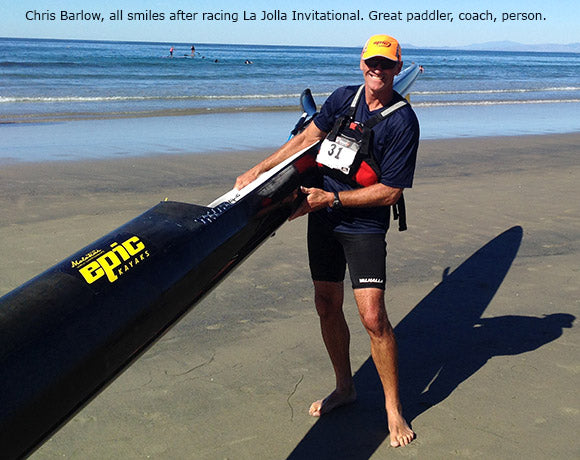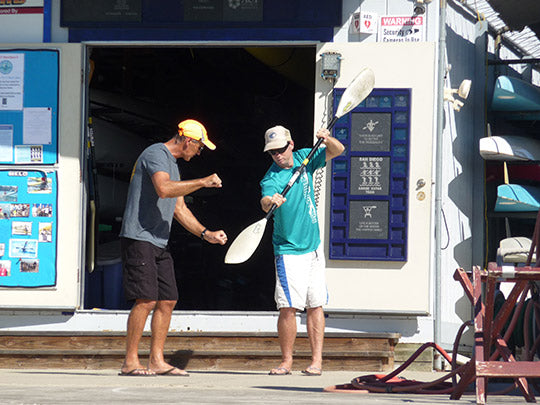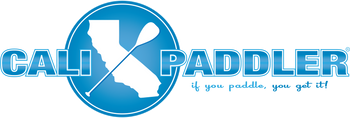 I had the most crazy nightmare. I was out on my outrigger canoe. Looked up at the sky for a second, and next thing I knew when I looked down, my ama was no longer there! Gone. Not there! I panicked that my paddle crutch was gone. Promptly huli’d. And woke up in a cold sweat!
I had the most crazy nightmare. I was out on my outrigger canoe. Looked up at the sky for a second, and next thing I knew when I looked down, my ama was no longer there! Gone. Not there! I panicked that my paddle crutch was gone. Promptly huli’d. And woke up in a cold sweat!
Ok so maybe I didn’t have that dream. But every outrigger paddler I know has at one time or another relied heavily on their ama to keep them dry and smiling. And even then, we have all still found ourselves wet from a huli. So the thought of that ama not being there is...scary! And yet, here are these paddlers I race against that usually catch way more bumps, and finish well in front of me on these ama-less paddle-crafts. They call them surfskis, and I found it was time I give these speed demons a ride! I mean after all, I have yet to find a paddle craft I didn’t like. Why would this not also be awesome? And beside, trying my luck with my oc1 in the shallows without its ama for 'fun' was mostly just 'wet' (the fun was had by those on the beach laughing at me).
After reaching out on FB for anyone who might have one I could borrow, I was given an invitation by Chris Barlow, coach at the San Diego Canoe and Kayak Team to come out for an introduction. Needless to say, I pounced on the thoughtful invite. For those of you not familiar with Chris, he is as humble and thoughtful a paddler you could ask to meet. But as is often the case with our awesome sport of paddling, humble can go hand-in-hand with fast. Chris is a former Olympian and has helped foster a very elite paddle program for canoe and kayak paddling and the only one of its kind in California. So yea, I had a chance to paddle a surfski…and get the coaching help of Chris? This outrigger paddler was stoked!

The day started out with a quick tour of the SDCKT facilities. Much like the facilities I seen at the Olympic Training Center in Otay, and Newport Aquatic Center in Orange County, there were rows and rows of various crafts hanging above, stacked on racks, and stored. SUPs, canoes, a wooden 4man canoe, kayaks, surfskis. It was like walking into a showroom and instantly knowing you were in the company of some awesome craft. Most of them foreign to me; all of them looking fast and fun.
Chris started off with some land training. Much like when I was first taught with outrigger, it is best to have an idea of what to do before hitting the water, and while I was eager to get wet, I was just as eager to have a clue out there when I was paddling. One of the first things that threw this outrigger paddler for a loop, Chris asked if I was left or right handed. “Uhhhhhh, I am left-handed?” I answered confusedly. Chris then explained and showed me how the paddles were actually built differently based on which hand you pivot when you alternate sides. Much like guitar though, he said I would be much more likely to find a right-handed paddle and suggested I use one of those. Worked for me.
We then broke down the grip, the body posture, and the qualities of a good stroke. So much was familiar.
Use arms: bad! Use legs and body: good!
Lean to the side: bad. Stay centered: good!
Rotation: Good. Keep your stroke up front. Don’t leave paddle in past your hips.

We broke the phases of the stroke down to familiar phases. Set-up. Catch. Power. Exit/Recovery…but wait! That is where it just got weird! As with a kayak, surfski has a blade on both sides. So unlike my normal world of paddling 15-30 strokes on one side before switching (100 when I am lost in la-la land), I would be alternating. And that is obviously different. But what was tricky to get at first on land, and in the water, was that the setup phase was the same as the recovery phase. I was taking my blade out on one side but setting my stroke up simultaneously on the other side. This was cool. And different. And both arms had significant technique to pay attention to!
So we worked through the stroke. Chris, who has probably done this tutorial 1000 times (this year alone), made me feel like I was his only athlete, and answered all sorts of questions as I asked them. Pretty soon, it was time to hit the water. We carried an Epic Surfski V7 down to the water, and he assured me it was on the stable side so I would hopefully not have too much trouble. I fully expected to get wet today. Repeatedly.

As I started the paddle portion of the day, I was surprisingly comfortable on it. His tip to keep my feet and knees in towards the center was counter intuitive to me. I always associate a wide stance as a stable one, but it was immediately clear to me that when my knees separated at all, I was gonna be flipping. So I gratefully heeded his suggestion. Unlike my OC1 and OC2, there are not individual foot wells, but one single foot well. And little foot straps like a rowing machine or ERG (shudder at the thought of getting on that anytime soon. Still recovering from my last time, 8 months ago!). The surfski had rudder pedals just like an OC1, but the pedal unit was moveable so it could slide forward or back and accommodate my height perfectly and keep my weight at the optimal position in the craft. “OC1s need this!” (said every surfski+oc1 paddler ever).
With each leg up and down the beach with Chris alongside on the beach coaching, critiquing and offering an encouraging voice, I started to feel more bold. Hadn’t fallen in yet! And as I was starting to think I was getting the hang of it, I would increase my rate. But each time I did, I would lose my technique and quickly realize I had to slow down again. Chris was quick to point out that doing it slow at first and correctly would lend to better habits from the start. So I slowed my horses, and fought the urge to pick up my rate every time I thought I was doing better.
Some big technique differences I came across while I was out there:
- A pause. In order to have a quality entry, I was told to include a pause before the catch phase where I enter the water. While my outrigger stroke has changed over the course of my 6 years (with various trends, coaches and teams), only once was there a pause in the stroke. And even then, it was minuscule, to allow the crew to ensure their timing. Almost imperceptible. Here though. It was dramatic; exaggerated so I could focus. Obviously as I get better the delay would be shortened, but as I watched video after of paddlers who really know what they are doing, it was still present in most elite paddlers too.
- Angle of stroke and exit. Unlike my outrigger stroke, which follows along the gunwales of the canoe in a parallel path, here the stroke would exit farther away then where it started. Almost like following the wake I was making.
- Elbows dropped. Rather than super assertive, which causes my shoulders to rise by my ears, my elbows were to be dropped down. As I would improve, over months, it was explained that they would be able to rise, but again we looked at posters on the wall later on and the Olympians were still much lower than I was initially doing from my outrigger background.
- Breaking the wrist. At the exit of a side, the wrist would break. Partially to help rotate/twist the paddle for proper entry on the other side, and also, to keep the rest of my arm, like my elbow, from breaking.
Those were the main 'techy' things I noticed. As far as the position, I felt much more lower in the craft and legs were slightly more straight out than I was used to. Not slouched by any means, but just more….well sorry outrigger canoe, but more comfortable. I didn’t paddle more than a mile, so not sure how I would fare over 20 miles, but it was extremely comfortable while I was out there.
So at this point, the question I would be wondering was, “did you flip yet?” And the answer...(throat clearing sound) “Not yet”.
But I sure came close a few times and you could hear Chris each time say, “whoah there!” As if he had a horse he was trying to calm. The ski was not as tippy as I feared. And this added to my excitement that the transition would be a fun one. Not that I mind a learning curve. In fact that is why I like new craft, as it’s so fun to try to get the hang of something different. But a tiny bit of confidence was present, that maybe, just maybe, I could get the hang of this new one without catching pneumonia or swallowing half of the pacific ocean. THAT SAID…we were on very flat water. On a calm windy day. On a surfski that regarded as a stable. So by NO means am I some sort of badass. Oh no.
And just to bring that point home, it was at this time, that Chris asked “Are you ready for the Acid Test?” "The whaaaat?" I replied sheepishly. Let’s just say, HAD I built up any sense of “I am a badass” I was about to lose it in the water and in turn, get the most humble dose I could ask for. And I couldn’t wait.
Chris brought out an Olympic K1 Eagle made by Van Dusen. This blue missile looking craft measured 17 ft and 26 pounds. Chris was smiling as he showed me that if you put it on the water by itself, it will immediately tip over. In other words, I was moving to the black diamond run of watercraft. “The acid test”, and what it entailed, became real clear to me.
So, not only was this ama-dependant fool gonna get a surfski paddle in, but also an olympic K1. So cool! I was completely ready to get wet. And don’t worry, I totally did. In fact this thing was so tough, that before I even got in, Chris had to spend a minute showing me the scripted method of getting in it. Brace the paddle behind my arm and lean on it. Other hand on the front of craft. Place left leg in first but on the right of craft, then right leg in crossing them. Then slowing lowering my body using 3 point stance of paddle hand and legs until I am seated. What a workout, and that was just to get in. Oh, and I am still totally relying now on the paddle to balance me as its dug into the shallow sand.

So, here I was, seated in super blue tippy monster, and every time Chris would take a stabilizing hand hand off the craft I would try and take my paddle out of the sand to use on either side like an ama and smooth the water. Each fall into the water was followed by having to tip the canoe 5 or 6 times in a certain way to drain all the resulting water out of it. The "tip of shame" I silently named it. So after about 10 tries, I managed to get a few hobbled meters forward before falling in again. Victory? I'll take it! That said my jersey STILL hasn’t completely dried from all the dunks. But man, I can’t wait to try again and master it (or at least get out of it one time on my own terms).
At the end of the my session I was really excited about these new craft. Different enough to know I would require some serious water time to get the hang of them, but similar enough to feel like I would have some sort of base to help my learning curve. In just the flat water I was trying, without any bumps and waves, I could already sense the speed potential a surfski would provide me. And having had ‘paddle-up’ moments in my 1 man outrigger in swell and bumps, that bring me back to my surfboard days, I could not wait to see what a surfski would lock me into. I am pretty confident it will be a whole new addiction. In fact, you can ask my wife, I went online to Craigslist that night after paddling and started researching what was out there. And pleasantly surprisingly enough, the cost was less than an outrigger canoe in the short time I looked. ("Hrmm, now how can I justify a new watercraft? I have some room in the dining room I believe for some new decor....") [Important follow up: If anyone is curious about the San Diego Canoe and Kayak Team, I urge you to visit their website at http://www.sdckt.net and give them a call. My only exposure to C1, K1 and Surfski was at the US National Championships and Paddle Fest this last summer, which left me with so many questions about these fast craft and their awesome junior and adult paddlers. SDCKT is unlike any other program in the state with their access to, and expertise with, these craft. And like any good paddling program, they are stoked to share their addiction.]
[Important follow up: If anyone is curious about the San Diego Canoe and Kayak Team, I urge you to visit their website at http://www.sdckt.net and give them a call. My only exposure to C1, K1 and Surfski was at the US National Championships and Paddle Fest this last summer, which left me with so many questions about these fast craft and their awesome junior and adult paddlers. SDCKT is unlike any other program in the state with their access to, and expertise with, these craft. And like any good paddling program, they are stoked to share their addiction.]
Team Writer Clarke Graves - If there is water, he will paddle it (regardless of craft). Clarke is a surfer turned paddler who grew up in San Diego but has traveled every corner of California enjoying its beauty and appeal. He has had the privilege of racing SUP, OC6, OC2, OC1, Prone and can't wait to hop into a dragon boat and surf-ski for an extended length of time.
One of Clarke's goals is to paddle as much shoreline in California as he can, with as many paddling friends who are willing to join him. If you have an idea for Clarke to write about or any questions, send it our way and we will pass it along!
















Pam WC - May 20, 2020
Excellent post, funny, and helped me decide if I have the guts to try a surfski! Thanks, I will… in the summer. It’s a bit colder up here on the PNW.
Stoked!